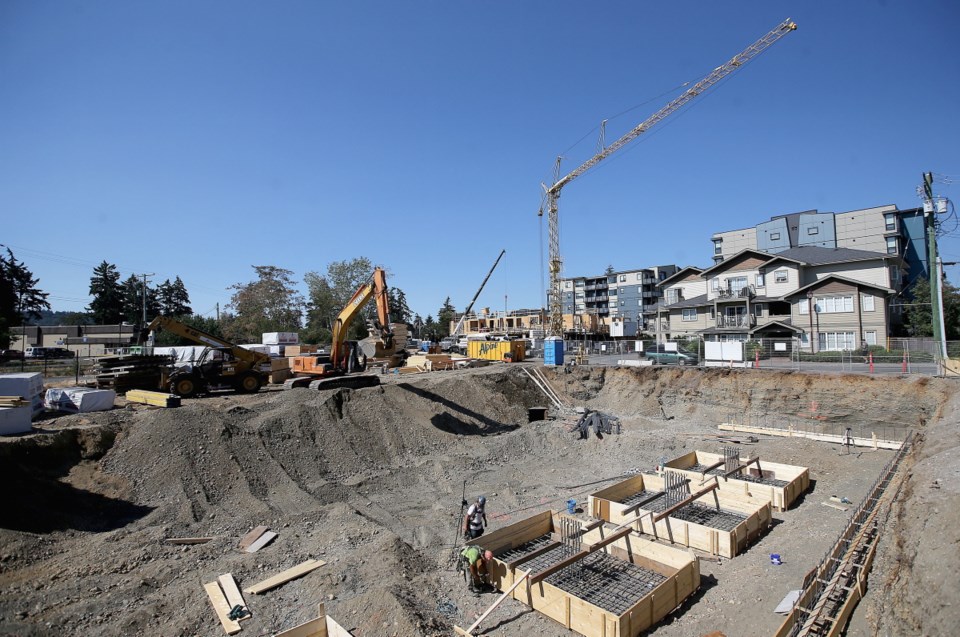DB Services Victoria is so busy building rental projects in Langford that it turns away new projects every month, says the company’s director of development.
The Langford-based firm is one of the developers supporting the West Shore’s building boom, where rental apartments, condominiums and single-family houses are under construction.
In the first seven months of this year, 911 housing units were started in Langford, far outpacing other Greater Victoria municipalities. Saanich followed with a distant 284 housing-unit starts.
So far this year, 2,185 homes have been started in the capital region, up from 1,913 for the same seven months in 2017, according to Canada Mortgage and Housing Corp.’s latest report.
And every CMHC report shows strong construction in the West Shore, where the population is growing and where councils say they are committed to an efficient approval system.
“We have been turning away work for about two years here. We have five years worth of work lined up on the books right now. It’s all rental stock,” said Matthew McKay, partner with his mother Margaret McKay and with Gary Lahnsteiner, in DB Services.
DB Services is building three rental projects in Langford. It builds and owns about one-third of its projects, with the rest constructed for clients. The Arc, at 2849 Bryn Maur Rd., is being built for a client. The six-storey, wood-frame building will have 93 units. “We just poured our first footing there today,” McKay said Thursday.
The Arc is next to Hockley Corners, 765 Hockley Ave., which will have 63 units and be owned by DB Services. It is the first residential building on Vancouver Island to be built with cross-laminated timber, although some local institutional buildings have used that product, he said. It replaces a traditional floor system.
“We erected today pretty much our whole floor system,” at Hockley Corners, McKay said. That work would normally take five days and require more workers.
Prefabricated cross-laminated timber floor panels, supported on glue-laminated timber and parallel strand lumber columns, were used in the University of B.C.’s 18-storey Brock Commons student residence, which opened in 2016.
DB Services’ third under-construction project is the 11-storey, steel-and-concrete Danbrook One, which will have 90 units in the core of Langford.
The company only builds rental. That type of housing is in demand in the growing West Shore and financing is easier to obtain with rental developments, because it is not conditional on presales, as with condominiums, McKay said.
In June, the company finished the 63-unit Peatt Commons Phase One, at 2854 Peatt Rd. “Before we even turned it over to the client it was fully rented,” he said.
Despite the year-to-date climb in housing starts, the 417 starts in July was lower than the 695 in the same month last year, CMHC said.
Month-to-month housing starts numbers can vary significantly depending on timing of projects. Longer-term figures reveal a more accurate picture of the state of housing construction.
The number of Greater Victoria homes under construction — some projects can take two years to complete — stood at 4,731 as of July, CMHC said.
As well, the value of building permits, which signal builders’ plans, has climbed.
The value of building permits in the region was $160.4 million in June, up by 29.5 per cent from June 2017 when the value was $123.8 million, Statistics Canada said in its monthly report.
June of this year was up by 9.2 per cent from May, when permit values reached $146.9 million.
“It is definitely the residential market that is driving some of our bigger numbers with the permit data. It’s continuing to demonstrate that it is a strong market,” said Rory Kulmala, chief executive of the Vancouver Island Construction Association.
Greater Victoria’s low rental vacancy rate is one factor driving market demand for more housing, he said. “I think we are seeing that in a lot of communities on Vancouver Island.”



